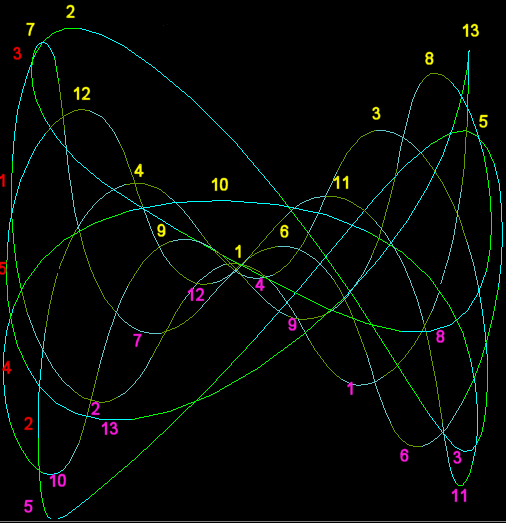
I've uploaded a picture showing the apparent orbit of Venus as seen from the earth for a period of 8 years. I've also illustrated where both 13 and 5 come from. I've labeled the northernmost progression of each pass with a yellow number, southernmost with pink, westernmost with red. The center of the picture corresponds to the sun's position. The starting point is in January 2000 (located just above the pink 8).
In summary, in 8 years, Venus traverses the sky east-west 5 times and north-south 13 times.
The creation of this illustration was inspired by a discussion about whether 8:5 or 8:13 was the proper ratio between earth's and Venus' orbits. This illustration shows that they both apply.
To understand the image, imagine if you were to record the position of Venus in the sky once per day over a period of 8 years. Now connect the dots. The field of view is centered on the sun and includes enough area to include the entire orbit. The result is the illustration. Perhaps it would help if axes were labeled. I will consider this if I regenerate the image.
Of course Venus is generally visible when the sun is blocked by the earth, so when Venus is in the western sky, one half of the picture is below the horizon. When Venus is in the eastern sky, the other half of the picture is below the horizon.
I should have also mentioned that the color of the line alternates between green and blue with the months of the Gregorian calendar. Light shades correspond to Venus being on the near side of the sun. Dark shades correspond to the far side of the sun. Knowing this, you can see the effect of the parallax caused by earth's close position to Venus: the lines move much further when bright than when dim because that is when Venus is closer to Earth. After 8 years, the line comes very near its starting point just above the pink 8. If the line were continued for hundreds of years, you'd see a band gradually filling in as if you had a very close view of a wedding band.
Venus is currently rounding the bend at the point marked by the pink #5 (count months from the start of the line at each point the color alternates between blue/green). To compare the picture to the current sky, since Venus is up in the evening, rotate the picture clockwise by 90 degrees so the red numbers (West) are on top. This picture tells me that Venus is approaching its maximum progress to the south (left) and is also near its maximum height above the horizon (red #2). Also, the color has just switched from dark to light, so Venus is now getting closer to Earth and will very quickly (about 2 months) become a morning star again.